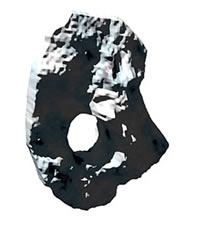
 |
 |
| Home |
| About Orkney |
| History |
| Tradition |
| Folklore |
| Placenames |
| Images |
| Downloads |
| About the Site |
| Contact |
| Links |
| Search Site |
| Awards |
| Dian-stanes and "Thunderstones" | |
|
However, within our surviving folklore, the distinction between the elf-arrow and the dian-stane has blurred. In some cases the object known as an elf-arrow - usually a prehistoric flint arrowhead, axe or knife - has also come to be referred to as a dian-stane. The thunderstone - divine protector For the origin of Orkney's dian-stane traditions we must turn to the root of the name itself, which is simply a corruption of the Norse term dynestein, meaning thunderstone. These thunderstones are found throughout Scandinavian folklore and tradition. They were generally quartz, or quartz-like, stones, pebbles, crystals or even flints - usually uncovered in fields when ploughing. The dynesteins were thought to fall from the sky during thunderstorms - missiles hurled by the pagan god Thor to to keep the wandering trolls under control. If a thunderstone struck a troll foolish enough to be out in a thunderstorm, instant death followed. According to Norwegian folklore, were it not for Thor's missiles, the trolls would have spread across the earth like a plague. The Orcadian version of the these thunderstones inevitably offered protection against trows - loosely an Orcadian variant of the troll - and so it was common for them to be built into the walls of houses or outbuildings. Incorporating a dian-stane into a building not only ensured that the trows left a farmstead alone, but was also thought to protect the structure from lightning. This protection from lightning is also recorded in Switzerland. There, during a storm, the thunderstone was tied to string and swung three times around the owner's head before being thrown at the door of his house. Luckystones - shadows of their former selves Over time, these powerful charmed stones became regarded as nothing more than lucky talismans. As the centuries passed, the potency of the dian-stanes decreased until, by the time of my childhood, they were simply referred to as "luckystones" or "luck stones". To carry such a pebble was thought to bring the bearer good luck - but only after spitting on them and polishing the surface. As a boy, numerous "luckystones" lay throughout the house, carried indoors whenever we found one. The holed talisman - a sun symbol? Inextricably tied up with the lore of the thunderstones are the ancient customs involving a separate class of protective stone - those that were holed or perforated. In a paper describing old Orkney farming customs, the writer Ernest Marwick had no doubts that the dian-stane was round, flat and holed. These holed stones were an integral part of spring's most important task - ploughing the fields. Before the introduction of the mechanical tractor, the dian-stane was strung, with strands of horsehair, from the body of the horse or ox-drawn plough. Then, while ploughing, the ploughman ensured that at the end of each furrow, when he turned to start another, the stone was moved to the other side of the plough. This ensured the stone always faced the sun. Once ploughing was complete, the dian-stane was hung from a nail in the dwellinghouse - always in a position that ensured it was bathed in sunlight. The reasoning behind this tradition is not certain but Ernest Marwick was convinced that the round stone represented the sun and symbolically ensured warmth returned to the cold earth. Is was also known for the crofter to use the dian-stane when venturing to sea on fishing trips. In these cases, the stone was taken from its resting place and worn around the neck. From accounts detailing customs surrounding these other holed stones, there is perhaps another common link - the horse. For some reason the holed stones were thought to be particularly effective at protecting horses and therefore hung in or outside stables. Although we have no surviving records connecting dian-stanes directly - or exclusively - to horses, there seems to have been a definite link. As we have seen, the stone had to be fastened to the plough with strands of horsehair. |
The holed stone remains a common sight across Orkney in the form of old millstones and quern stones. These are usually seen propped up outside houses, dykes, crofts and byres. These days, it is doubtful that anyone remembers the reason these old weathered stones were placed in these locations. Whether it was purely for decorative purposes or whether they were regarded as some form of lucky or protective talisman we can only guess. Based on the traditions surrounding the smaller versions of the holed stone, I suspect that at some point in Orkney's history, the latter was the case. |
